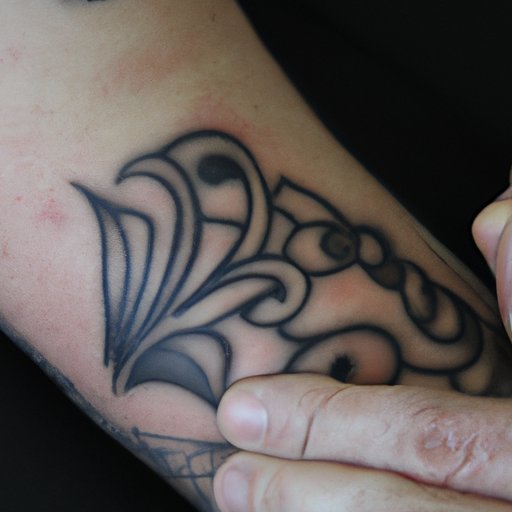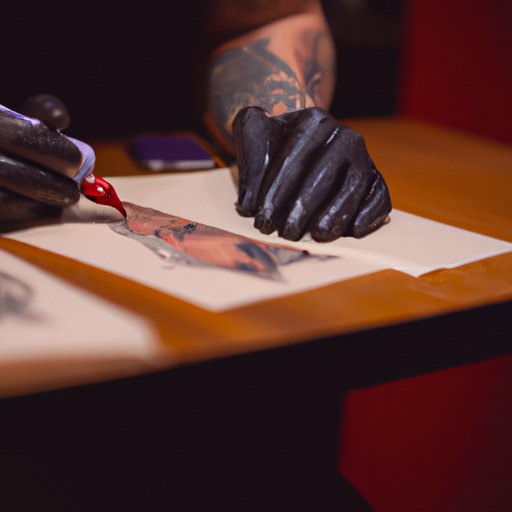Introduction
The art of tattooing has been practiced for centuries, but how far back does it go? In this article, we explore the history of tattoos, from their earliest known use to the modern-day art form. We examine the various techniques used throughout time, as well as the symbolism and rituals associated with them. We also investigate the mystery of when tattoos were first invented and the debates surrounding this issue. By the end of this article, you will have a better understanding of the origins of tattooing and its evolution over time.
Historical Perspective: Tracking the Origin of Tattoos
Tattooing is an ancient art form that has been practiced by many cultures throughout history. It is believed to have originated in Neolithic times, around 12,000 years ago, although the earliest known tattoo was found on the body of Ötzi the Iceman, who lived in the Alps more than 5,300 years ago. This discovery has led researchers to believe that tattooing may have originated even earlier than previously thought.
Tattoos have long been used to express identity, spirituality, and cultural beliefs. They have served as symbols of status, protection, and beauty, and have been used in religious ceremonies and rites of passage. For many cultures, tattoos are a way of marking significant milestones, such as birth, marriage, or death.
A Look Back in Time: The Art of Tattooing Through the Ages
Throughout history, different cultures have practiced tattooing using various techniques. The tools used to create tattoos have varied, from sharpened stones to needles made of bone or metal. The ink used has also changed over time, from natural pigments derived from plants and minerals to modern-day inks made from synthetic materials.
Tattoos have had different meanings in different cultures. In some cultures, they were used to mark criminals or slaves, while in others, they were symbols of beauty and power. In some cultures, tattoos were seen as a form of protection, while in others, they were seen as a way to communicate with the gods. Regardless of their purpose, tattoos have always been a powerful way of expressing identity and conveying meaning.

Tracing the History and Evolution of Tattoos
In order to understand the history and evolution of tattoos, it is important to look at the archaeological evidence of tattooing. Through excavations of ancient sites, researchers have been able to uncover artifacts that provide clues about the early practices of tattooing. These artifacts include tools used for tattooing, as well as remains of tattooed individuals.
By examining these artifacts, researchers have been able to piece together a clearer picture of the origins of tattooing. For example, through the study of ancient tools, researchers have determined that early tattooing techniques involved the use of sharpened stones and other primitive tools. Similarly, the examination of remains has revealed evidence of tattoos that date back thousands of years.
An Exploration of Ancient Tattoo Practices
In addition to studying the artifacts of tattooing, researchers have also explored the various cultures that practiced tattooing throughout history. Through this research, they have gained insight into the symbolism and rituals associated with ancient tattoos. For example, in some cultures, tattoos were used to mark significant life events, such as reaching adulthood or getting married. In other cultures, tattoos were used as protection against evil spirits or as a sign of devotion to a particular deity.
Ancient cultures also used different techniques for tattooing. Some used hand-tapping methods, while others used tools such as combs or needles. In some cultures, tattoos were created using natural pigments derived from plants and minerals, while in others, tattoos were made using soot or ash.

Unearthing the Mystery of When Tattooing Was First Invented
Although there is evidence of tattooing dating back thousands of years, the exact origin of the practice is still a mystery. There is no consensus among archaeologists and historians as to when, exactly, tattooing was first invented. Some believe that the practice originated in Africa or the Middle East, while others argue that the earliest known tattoos were found in Europe.
One of the most widely accepted theories is that tattooing originated in Polynesia. This theory is supported by the tattoo designs found on ancient Polynesian artifacts, as well as the oral histories of the Polynesian people. According to one such legend, the god of tattooing, Mata Nui, bestowed the gift of tattooing upon humans. This story suggests that tattooing has been practiced in the region since ancient times.
Despite the lack of consensus regarding the exact origin of tattooing, there is general agreement that the practice dates back thousands of years. This is supported by the archaeological evidence of tattooing, as well as the various cultures that have practiced the art throughout history.

Investigating the Origins of the Art of Tattooing
Today, the art of tattooing has evolved significantly from its ancient roots. Modern-day tattooists use a variety of tools and techniques to create intricate designs, often combining traditional methods with newer technologies. Despite the changes, tattoos remain a powerful way of expressing identity and conveying meaning.
In recent years, tattoos have become increasingly popular, with more and more people getting inked for a variety of reasons. As the popularity of tattoos continues to grow, so too does our understanding of the history and evolution of the art form. Through further research, we can continue to uncover the secrets of tattooing’s past and gain insight into the fascinating history of this ancient art.
Conclusion
In conclusion, we have explored the history of tattoos, from their earliest known use to the present day. We have examined the various techniques used for tattooing throughout time and investigated the mystery of when tattoos were first invented. Through this exploration, we have gained a better understanding of the origins of tattooing and its evolution over time.
(Note: Is this article not meeting your expectations? Do you have knowledge or insights to share? Unlock new opportunities and expand your reach by joining our authors team. Click Registration to join us and share your expertise with our readers.)
